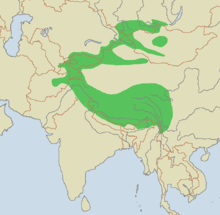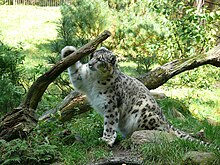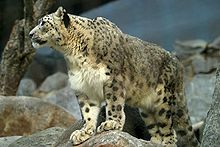Snow leopard
| Snow leopard | |
|---|---|

| |
| Scientific classification | |
| Kingdom: | |
| Phylum: | |
| Class: | |
| Order: | |
| Family: | |
| Subfamily: | |
| Genus: | Uncia Gray, 1854
|
| Species: | U. uncia
|
| Subspecies: |
|
| Binomial name | |
| Uncia uncia (Schreber, 1775)
| |

| |
| Range map | |
| Synonyms | |
The snow leopard (Uncia uncia or Panthera uncia), sometimes known as ounce, is a moderately large cat native to the mountain ranges of Central Asia. The classification of this species has been subject to change and its exact taxonomic position will not be resolved until further studies are conducted.
Description
Snow leopards are smaller than the other big cats but like them, exhibit a range of sizes, generally weighing between 27 and 54 kilograms (60 and 120 lb). Body length ranges from 75 to 130 centimetres (30 to 50 in), with a tail of nearly the same length.[3]
Snow leopards have long thick fur, the base colour of which varies from smoky grey to yellowish tan, with whitish underparts. They have dark grey to black open rosettes on their body with small spots of the same colour on their heads and larger spots on their legs and tail.[3]
Snow leopards show several adaptations for living in a cold mountainous environment. Their bodies are stocky, their fur is thick, and their ears are small and rounded, all of which help to minimize heat loss. Their feet are wide, which distributes their weight better for walking on snow, and they have fur on their undersides to increase their traction on steep and unstable surfaces, as well as to assist with minimising heat loss. Snow leopards' tails are long and flexible, helping them to maintain their balance. The tails are also very thickly covered with fur which, apart from minimising heat loss, allows them to be used like a blanket to protect their faces when asleep.[3][4]
Snow leopards cannot roar, despite possessing some ossification of the hyoid bone. The presence of this ossification was previously thought to be essential for allowing the big cats to roar, but new studies show that the ability to roar is due to other morphological features, especially of the larynx, which are absent in the snow leopard.[5][6]
Taxonomy
In the past, many taxonomists included the snow leopard in the genus Panthera, together with the other largest extant felids, but later it was placed in its own genus, Uncia. It was thought not to be closely related to the leopard (Panthera pardus). However, a recent molecular study would place the species firmly within the genus Panthera, with its closest relative being the tiger (Panthera tigris), although its exact position remains unclear, and many sources still treat it as Uncia pending further studies.[7]
A few subspecies have been proposed for animals living in different geographical regions and these are listed under subspecies in the taxobox on the right. With the possible exception of U. u. baikalensis-romanii which requires further evaluation, these subspecies were generally not considered valid.[2] However, the Handbook of the Mammals of the World recognizes two subspecies: U. u. uncia, from central Asia northwestwards to Mongolia and Russia; and U. u. uncioides in western China and the Himalayas.[8]
Etymology
Both the Latinised genus name Uncia and the occasional English name "ounce" are derived from the Old French once, originally used for the European lynx. "Once" itself is believed to have arisen by back-formation from an earlier word "lonce" – the "L" of "lonce" was construed as an abbreviated "le" ("the"), leaving "once" to be perceived as the animal's name. This, like the English version "ounce", became used for other lynx-sized cats, and eventually for the snow-leopard.[9][10]
Distribution
The snow leopard's range in central and south Asia is rugged mountainous regions of approximately 1,230,000 square kilometres (470,000 sq mi), which extends through twelve countries: Afghanistan, Bhutan, China, India, Kazakhstan, the Kyrgyz Republic, Mongolia, Nepal, Pakistan, Russia, Tajikistan, and Uzbekistan.
The geographic distribution runs from the Hindukush in eastern Afghanistan and the Syr Darya through the mountains of Pamir Mountains, Tian Shan, Karakorum, Kashmir, Kunlun, and the Himalaya to southern Siberia, where the range covers the Russian Altai mountains, Sajan, Tannu-Ola mountains and the mountains to the west of Lake Baikal. In Mongolia it is found in the Mongolian and Gobi Altai and the Khangai Mountains. In Tibet it is found up to the Altyn-Tagh in the North.[11]
Ecology and behaviour
In summer, the snow leopard usually lives above the tree line on mountainous meadows and in rocky regions at an altitude from 2,700 to 6,000 m (8,900 to 19,700 ft). In winter, it comes down into the forests to an altitude of around 2,000 m (6,600 ft). It leads a largely solitary life, although mothers may rear cubs for extended periods of time in dens in the mountains.
An individual snow leopard lives within a well defined home range but does not defend its territory aggressively when encroached upon by other snow leopards. Home ranges vary greatly in size. In Nepal, where prey is abundant, a home range may be as small as 12 km2 (5 sq mi) to 40 km2 (15 sq mi) and up to five to ten animals are found here per 100 km2 (39 sq mi); whereas in habitats with sparse prey, an area of 1,000 km2 (386 sq mi) supports only five of these cats.[5]
Snow leopards are crepuscular, being most active at dawn and dusk.[3]
Diet
Snow leopards are carnivores and actively hunt their prey. However, like all cats, they are opportunistic feeders, eating whatever meat they can find including carrion and domestic livestock. They are capable of killing animals three times their size but will readily take much smaller prey such as hares and birds.[4]
The diet of the snow leopard varies across its range and with the time of year, and is dependent on prey availability. In the Himalayas it preys mostly on bharals (Himalayan blue sheep) but in other mountain ranges such as the Karakorum, Tian Shan, and Altai, its main prey consists of Siberian ibex and argali, a type of wild sheep, although this has become rarer in some parts of the snow leopard's range.[3][12] Other large animals eaten include various types of wild goats and sheep (such as markhors and urials), other goat-like ruminants such as Himalayan tahr and gorals, plus deer, boars, and langur monkeys. Smaller prey consists of marmots, woolly hares, pikas, various rodents , and birds such as the snow cock and chukar.[3][4][12][13]
It is not averse to taking domestic livestock, which brings it into direct conflict with humans. Herders will kill snow leopards to prevent them from taking their animals.[4]
Snow leopards prefer to ambush prey from above and can leap as far as 14 meters (46 ft).[14]
Life cycle
Snow leopards usually mate in late winter and have a gestation period of 90–100 days. Litter sizes vary from one to five cubs but two or three is more usual. The cubs remain with their mother until they become independent after around 18–22 months.[3] Snow leopards normally live for 15–18 years, but may live for up to 20 years in captivity.
Population and conservation


The total wild population of the snow leopard was estimated at between 4,100 and 6,600 individuals by McCarthy et al 2003 (see table below). Many of these estimates are rough and outdated.[1]
In 1972 the International Union for Conservation of Nature, (IUCN) placed the snow leopard on its Red List of Threatened Species as globally "Endangered"; the same threat category was applied in the assessment conducted in 2008.
There are also 600-700 snow leopards in zoos around the world.[15]
| Range Country | Habitat Area (sq. km.) |
Estimated Population[1] |
|---|---|---|
| Afghanistan | 50,000 | 100-200? |
| Bhutan | 15,000 | 100-200? |
| China | 1,100,000 | 2,000-5,000 |
| India | 75,000 | 200-600 |
| Kazakhstan | 50,000 | 180-200 |
| Kyrgyz Republic | 105,000 | 150-500 |
| Mongolia | 101,000 | 500-1000 |
| Nepal | 30,000 | Unknown-probably quite high |
| Pakistan | 80,000 | 200-420 |
| Tajikistan | 100,000 | 180-220 |
| Uzbekistan | 10,000 | 20-50 |

Protected Areas:
- Chitral Gol National Park, in the NWFP, Pakistan.
- Hemis National Park, in east Ladakh, India.
- Khunjerab National Park, Northern Areas, Pakistan.
- Nanda Devi National Park, in state of Uttarakhand, India, a UNESCO Natural World Heritage Site.[16]
- Qomolangma National Nature Preserve, Tibet, China.[17]
- Sagarmatha National Park, Nepal, a UNESCO Natural World Heritage Site.[18]
- Tumor Feng Nature Reserve, western Tianshan Mountains, Xinjiang, China.[19]
- Valley of Flowers National Park, Uttaranchal, India, a UNESCO Natural World Heritage Site.
- Shey-Phoksundo National Park, Dolpa, Nepal.
- Dhorpatan Hunting Reserve,Baglung, Nepal.
- Annapurna Conservation Area, Western Nepal.
- Jigme Dorji National Park, Bhutan
- Gobi Gurvansaikhan National Park, Mongolia
- Ubsunur Hollow, on the territorial border of Mongolia and the Republic of Tuva, Russia
Much progress has been made in securing the survival of the snow leopard, with snow leopards being successfully bred in captivity. The animals usually give birth to two to three cubs in a litter, but can give birth to up to seven in some cases.
Conservation efforts
There are numerous agencies working to conserve the snow leopard and its threatened mountain ecosystems. These include the Snow Leopard Trust, the Snow Leopard Conservancy and the Snow Leopard Network. These groups and numerous national governments from the snow leopard's range, non-profits and donors from around the world recently worked together at the 10th International Snow Leopard Conference in Beijing. Their focus on research, community programs in snow leopard regions and education programs are aimed at understanding the cat's needs as well as the needs of the villagers and herder communities impacting snow leopards' lives and habitat.[20][21]
Snow leopard in heraldry
Snow leopard have symbolic meaning for turkic people of central asia (where animal is known as irbis or bars), so it is widely used in heraldy and as an emblem. The snow leopard (in heraldry known as the ounce) (Aq Bars) is a national symbol for Tatars and Kazakhs: a snow leopard is found on the official seal of the city of Almaty, and a winged snow leopard is found on Tatarstan's coat of arms. A similar leopard is featured on the coat of arms of North Ossetia-Alania. The snow leopard award was given to Soviet mountaineers who scaled all five of the Soviet Union's 7000m peaks. In addition, the snow leopard is the symbol of the Girl Scout Association of Kyrgyzstan.
-
Snow leopard on the reverse of the old 10000 tenge (Kazakhstan) banknote.
-
Snow leopard as a symbol of Almaty, Kazakhstan.
-
Snow leopard as a symbol (old coat of arms) of Astana, the capital of Kazakhstan.
-
Snow leopard as a symbol of Bishkek, the capital of Kyrgyzstan.
-
Snow leopard on coat of arms of Shushensky district, Krasnoyarsk Krai.
References
- ^ a b c Template:IUCN2008
- ^ a b Wozencraft, W. C. (2005). "Order Carnivora". In Wilson, D. E.; Reeder, D. M. (eds.). Mammal Species of the World: A Taxonomic and Geographic Reference (3rd ed.). Johns Hopkins University Press. p. 548. ISBN 978-0-8018-8221-0. OCLC 62265494.
- ^ a b c d e f g "Snow Leopard Fact Sheet" (PDF). Snow Leopard Trust. 2008. Retrieved 2008-10-23.
- ^ a b c d "Snow Leopard profile". National Geographic. 2008. Retrieved 2008-10-23.
- ^ a b Nowak, Ronald M. (1999). Walker's Mammals of the World. Johns Hopkins University Press. ISBN 0-8018-5789-9.
- ^ Weissengruber, GE (2002). "Hyoid apparatus and pharynx in the lion (Panthera leo), jaguar (Panthera onca), tiger (Panthera tigris), cheetah (Acinonyx jubatus) and domestic cat (Felis silvestris f. catus)". Journal of Anatomy. Anatomical Society of Great Britain and Ireland. pp. 195–209. doi:10.1046/j.1469-7580.2002.00088.x. Retrieved 2007-05-20.
{{cite web}}: Unknown parameter|coauthors=ignored (|author=suggested) (help); Unknown parameter|month=ignored (help) - ^ Johnson, W.E. (6 January 2006). "The Late Miocene radiation of modern Felidae: A genetic assessment". Science. 311 (5757): pp73-77. doi:10.1126/science.1122277. Retrieved 2008-10-24.
{{cite journal}}:|pages=has extra text (help); Unknown parameter|coauthors=ignored (|author=suggested) (help) - ^ Wilson DE, Mittermeier RA (eds) (2009) Handbook of the Mammals of the World. Vol. 1. Carnivores. Lynx Edicions, Barcelona
- ^ Allen, Edward A (1908). "English Doublets". Publications of the Modern Language Association of America. 23 (new series 16: 214.
- ^ Oxford English Dictionary, Oxford University Press. 1933: Ounce
- ^ Mammals of the Soviet Union. Vol III: Carnivores (Feloidea).
- ^ a b Jackson, Rodney (1996). "Snow Leopard Survey and Conservation Handbook Part III" (pdf). Snow Leopard Survey and Conservation Handbook. Seattle, Washington, & Fort Collins Science Center, Colorado, US: International Snow Leopard Trust & U.S. Geological Survey. p. 66. Retrieved 2009-03-14.
{{cite web}}: Unknown parameter|coauthors=ignored (|author=suggested) (help) - ^ unknown (2004). "Conservation of the Snow Leopard in Nepal" (pdf). Seattle, US: The Snow Leopard Network. p. 2. Retrieved 2009-03-14.
- ^ "Animal Bytes: snow leopard". San Diego Zoo. 2007. Retrieved 2007-05-05.
- ^ "Population and Protections". Snow Leopard Trust. 2008. Retrieved 2008-07-03.
- ^ UNESCO World Heritage Centre Nanda Devi and Valley of Flowers National Parks. Brief Description. Retrieved 27 November 2006.
- ^ Snow Leopard Conservancy. 2006. Training park managers in the conservation of snow leopards. Retrieved 27 November 2006.
- ^ UNESCO World Heritage Center. Sagarmatha National Park: Brief Description. Retrieved 27 November 2006.
- ^ Snow Leopard Network. 2005. Camera Trapping of Snow Leopards in the Muzat Valley. Retrieved 27 November 2006.
- ^ Theile, Stephanie “Fading footprints; the killing and trade of snow leopards” TRAFFIC International, 2003
- ^ Foreign Correspondent,"Cats in the Clouds", Australian Broadcasting Corporation, 2009. Retrieved 27 June 2009.







